The WaterSense Current Winter 2010
In This Issue XIII, Winter 2010:
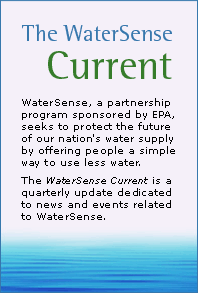 |
In This Issue: |
Find. Fix. Save. Fix a Leak Week Makes a Difference
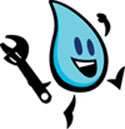
Don't mistake dripping noises this winter for the sound of melting snow. It could be a leaking faucet, running toilet, or dripping shower. Household leaks cost homeowners thousands of gallons of water each year. In fact, 1 trillion gallons of water are wasted from residential leaks in the United States every year.
EPA's WaterSense program is sponsoring Fix a Leak Week, March 15 to 21, 2010, to encourage homeowners to find and fix leaks. There are steps you can take to save water with do-it-yourself fixes that can take minutes and cost only a few dollars.
Now is a great time to find out if you have household leaks because we usually use less water outside this time of the year. If your family's water bill exceeds 12,000 gallons per month, chances are you have a leak or two.
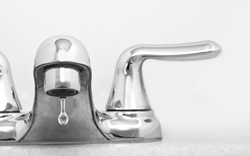
The first step to savings is to find the leaks. Seeking out leaks can be as easy as walking around your house and looking and listening for them. Sometimes leaks can be sneaky; toilets, for example, often have silent leaks. Place a couple drops of food coloring into the toilet tank, wait 15 minutes without flushing, and if color appears in the bowl you know you have a leak. Flush afterward to avoid staining the toilet. Often an old, worn rubber flapper inside the tank is the culprit for a leaky toilet. Replacing the flapper only costs a few dollars and is simple enough to do yourself. Even tightening a dripping faucet connection can save hundreds of gallons annually.
The next step, fixing leaks, can often be done with tools you already have around the house. Don't forget to check pipes under sinks that could leak as well. A wrench and some pipe tape can help fix a dripping showerhead, which, if left alone dripping at a rate of 10 drips per minute, can waste 500 gallons a year. At a rate of 1 drip per second, it could waste 3,000 gallons a year!
If you find that you need to replace plumbing fixtures, save even more water by replacing them with WaterSense labeled models. WaterSense labels toilets, faucets, urinals, and--coming soon--showerheads that use at least 20 percent less water and are independently tested and certified to perform as well as or better than standard plumbing fixtures. Learn more about Fix a Leak Week, March 15 to 21, 2010.
WaterSense Opens the Door for Homes That Save
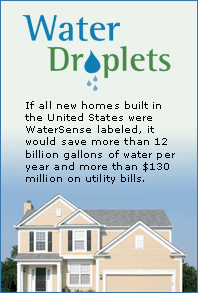
Thinking about buying a new home in 2010? Make it one certified to save water and energy. EPA released its final specification for WaterSense labeled new homes in December 2009; this means that like individual products that bear the WaterSense label, new homes can now earn the WaterSense label. Home buyers who invest in a WaterSense labeled new home can be confident it has been built for quality and efficiency, both indoors and out, and will use 20 percent less water than a typical new home.
WaterSense joins the ranks of other voluntary green home programs such as the U.S. Green Building Council's Leadership in Energy and Environmental Design (LEED®), National Green Building Standard™, and ENERGY STAR® for Homes, but WaterSense is the first national program to offer a label specifically for water-efficient residences.
WaterSense labeled homes include an efficient hot water delivery system that is designed to reduce time spent waiting for hot water to reach the tap. All bathrooms feature WaterSense labeled plumbing fixtures, which can save up to 5,000 gallons of water per year. In fact, WaterSense labeled homes can help American home buyers reduce their water usage by more than 10,000 gallons of water per year—enough to fill a backyard swimming pool—and save enough energy annually from heating less water to power a television for four years. This translates into at least $100 savings each year on water and energy bills compared with other new homes. Compared to older, existing homes, WaterSense labeled homes help families save more than $200 per year.
Additional features of WaterSense labeled homes include ENERGY STAR qualified dishwashers and clothes washers (if these appliances are installed) and landscaping designed for your local climate that requires less watering. EPA offers options for builders to work with home buyers and landscape designers to select plantings that ensure curb appeal with healthy, beautiful front yards that use less water than their traditional counterparts.
Buying a WaterSense labeled new home is a smart investment that will impact not only your family's future, but will help save water and resources for your community and future generations. Builders across the country are partnering with EPA to offer WaterSense labeled new homes. See a full list of builder partners or learn more about WaterSense labeled new homes.
Second WaterSense Labeled Home Completed in North Carolina
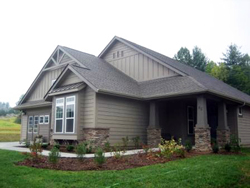
Nappier & Turner Construction Co., Inc. crossed the threshold into water efficiency with the completion of its first WaterSense labeled new home in late 2009. As a participant in the WaterSense new homes pilot program, Nappier & Turner, based in Hendersonville, North Carolina, has helped lay the foundation for builders across the country to construct WaterSense labeled new homes.
"It feels good to complete our model home and to be able to show consumers how this home is a solution to some of the issues we face today," says Jeff Huntley, president of Nappier & Turner. "This program is a continuation of our commitment to building sensible, green homes that are designed to work well for occupants and are easy on our natural resources. WaterSense gives us the guidelines to help make the right decisions with the homes we are building."
As one of seven builders chosen in August 2008 to participate in EPA's new homes pilot program, Nappier & Turner's home is the second home to be built to the WaterSense draft specification for new homes. Vanguard Homes finished the first WaterSense labeled home as part of the pilot in Chapel Hill, North Carolina, in early 2009.
Crimson Tide Saves a Lot of Blue
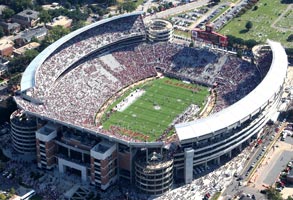
The next time University of Alabama running back and 2009 Heisman Trophy winner Mark Ingram steps onto the field for the 2010 football season, the Crimson Tide fans cheering him on will be doing their part to save water, thanks to a recently completed stadium addition that's using water-efficient plumbing fixtures.
When considering the 9,000-seat addition, university officials realized the water infrastructure in Bryant-Denny Stadium would be stretched to the limit. To accommodate more fans, additional toilets and urinals were needed. Officials considered other methods to reduce the strain on existing water and sewer lines, but decided more efficient toilets and urinals best solved their problem.
Just as the Crimson Tide performed as leaders on the field in the 2009–2010 season, winning the national title, finishing with a perfect 13-0 regular season, and celebrating Ingram's Heisman win by the smallest point margin in history, the stadium has also become a leader in helping save water.
More efficient toilets and urinals, like those that have earned the WaterSense label, save water while still performing as well as or better than standard models. Bryant-Denny Stadium will save at least 350,000 gallons of water a season from upgrading its urinals alone. That's enough water to cover the football field with water 10 inches deep.
Bryant-Denny is not the only sports facility upgrading to more efficient plumbing fixtures. In recent years, the Denver Nuggets' Pepsi Center, the Atlanta Hawks' Phillips Arena, and the Dallas Cowboys' Stadium are among others who have made an effort to use water more efficiently.
Partner Profile: James City Service Authority
The WaterSense Current periodically profiles outstanding WaterSense partners and their achievements in advancing water efficiency and water-efficient products and practices.

James City Service Authority (JCSA), a water utility serving approximately 46,000 people in coastal Virginia, offers its customers rebates for one of the widest varieties of water-using products in the Southeast, helping it to win a 2009 WaterSense Partner of the Year award. WaterSense got in touch with Beth Davis, JCSA utility analyst, to find out why this utility makes saving water a priority.
WaterSense: What water issues are unique to James City County and Williamsburg, Virginia?
Beth Davis, JCSA: JCSA is the largest water utility in the state of Virginia that is reliant on groundwater. One of our greatest challenges is increased outdoor water use during the summer months, when 60 to 70 percent of municipal water is used by James City County residents for landscape irrigation.
WaterSense: Why has your utility turned to water efficiency and how has WaterSense helped?
Beth Davis, JCSA: Water conservation is critical to meet our future water needs and preserve this limited natural resource. WaterSense has helped this process by enhancing the market for water-efficient products, programs, and practices that we educate our customers about. We are very excited to have won the WaterSense Partner of the Year award, which has brought national and regional recognition of our water conservation efforts.
WaterSense: What are your most popular rebates?
Beth Davis, JCSA: To date our most popular rebates are rain barrels and washing machines; although, WaterSense labeled toilets have gained more popularity. If residential water customers retrofit their old toilet with a WaterSense labeled model, they may receive a rebate of up to $40 per toilet. I have received feedback from customers who have stated that they have seen a difference in their water bills already by doing this.
WaterSense: What do you think is the most important step homeowners can do to save water?
Beth Davis, JCSA: I think the most important step homeowners can do to save water is to be aware of their purchasing decisions when buying a product that uses water, monitoring their water bill for consumption, and periodically auditing their home for leaks both inside and out.




